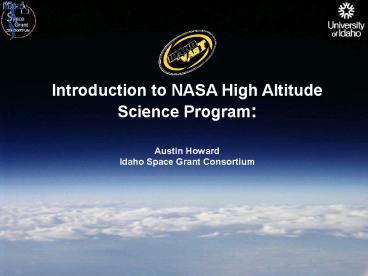Introduction to NASA High Altitude Science Program: - PowerPoint PPT Presentation
1 / 21
Title:
Introduction to NASA High Altitude Science Program:
Description:
On-board data storage. Power. Microprocessors. Programming. Ground Station. Antenna pointing ... Photo/video record keeping (PR video?) Public website maintenance ... – PowerPoint PPT presentation
Number of Views:102
Avg rating:3.0/5.0
Title: Introduction to NASA High Altitude Science Program:
1
Introduction to NASA High Altitude Science
Program Austin Howard Idaho Space Grant
Consortium
2
Background
- Idaho Space Grant joined the National Space
Grant Student Satellite Crawl, walk, run, fly!
Program in 2003 with Introduction of Idaho RISE - First element of this program is Crawl to
develop capability to build, test, fly, operate,
and recover scientific hardware from high
altitude balloons. - Next Steps
- Walk Suborbital/sounding rocket flights
- Fly Satellites for Earth orbit
- Run Spacecraft for deep space operations
3
Flight History
- RISE 03_01 5 Apr 2003 94,000 feet
- RISE 03_02 12 June 2003 98,000 feet
- RISE 03_03 24 July 2003 88,000 feet
- RISE 04_01a 28 Aug 2004 90,000 feet
- RISE 04_01b 28 Aug 2004 100,700 feet
- RISE 04_02 26 Sept 2004 87,000 feet
- RISE 05_01 10 Apr 2005 91,000 feet
- RISE 05_02 29 Oct 2005 Unknown
- RISE 06_01 25 Feb 2006 40,000 feet
- RISE 06_02 22 Oct 2006
10,000 feet - RISE 07_01 21 Apr 2007
89, 000 feet - RISE 07_02 15 May 2007
84,000 feet
4
What is VAST?
- VAST Vandal Atmospheric Science Team
- Chapter of Idaho Space Grant RISE Program
Research Involving Student Engineers and
Educators - Multidisciplinary program involving students in
- Engineering
- Physics
- Chemistry
- Life Sciences
- Education
- Business
- Students design, build, test and fly science
payloads up to 100,000 ft and beyond
5
The View From The Top
6
The View From The Top
7
Vision
8
What Do I Get Out Of This?
- Hands on experience applying knowledge build both
in and out of class work - Build connections and relationships with people
from a variety of disciplines and experience
levels - Including students/faculty connected to NASA
- Freedom to experiment and learn your own way
- Experience working in groups
- Possibility for leadership experience
9
Perspective
- Commercial airlines cruise between
30,000-40,000ft - (9-12 km)
- International Space Station orbits at around
1,150,000 ft (350km) - Balloons can reach above 100,000 ft (30 km)
- Pressure 1 of sea level
- (near vacuum, about the same as surface of
Mars) - Temperatures low as -50o F (-46o C)
- Sky is black
10
VAST!
11
Organization
12
Teams
- VAST Teams
- Science/Instrumentation
- Define science requirements
- Specify and calibrate/test instruments
- Communications
- Flight hardware (GPS, radios, antennas)
- Armature radio video broadcast
- Structures/Thermal
- Thermal design
- Packaging
- Rigging/descent
13
Teams Cont
- VAST Teams
- Control and Data Handling
- On-board data storage
- Power
- Microprocessors
- Programming
- Ground Station
- Antenna pointing
- Data archiving
- Organize tracking/recovery efforts
- Launch planning
14
Teams Cont
- VAST Teams
- Outreach (Marketing, PR, Education, Graphic
Design) - Graphic design (T-shirts, posters, fliers)
- High school student mentoring
- Photo/video record keeping (PR video?)
- Public website maintenance
- Building connections to professional
organizations (ASME, SWE, IEEE, Engineering
hall) - Program Management (Business)
- Strategic planning
- Budget management
- Define, prioritize, and budget tasks
- Inventory tools and supplies
15
Projects
- Last Semesters Projects
- Broadcast live TV from payload
- Temperature/Acceleration sensors
- On-board computer
- Current Projects
- Basalt magnetic field sensing experiment
- Small atmospheric entry probe prototype
development - Improved imaging capabilities/Command uplink
capability - Data logging board development
16
Magnetic Field Sensing
- Project Goals
- Construct a low-cost, low-power, lightweight
magnetometer for mapping earth fields - Fly magnetometer on RISE balloon measure rock
magnetization along flight path - Demonstrate ability to overcome technical
difficulties - sensor orientation
- altitude variations (possibly altitude control)
- topographic corrections
17
Entry Probe Development
- Project Goals
- Design a light weight entry probe prototype that
has the ability to - Obtain atmospheric density, pressure, and
temperature as a function of altitude throughout
an entire simulated entry flight test - Collect data at 10hz sample rate
- Communicate data through telemetry
- Survive impact or send all data prior to impact
- Probe will not have a parachute
18
Misc. Technology Development
- Project Goals
- Develop uplink command capability
- Improved still imaging
- Develop remote control imaging/experiment
platform - Develop autonomous directional tracking station
19
Expectations/Syllabus
20
Are Your Ready to Make History?
- This is uncharted territory
- Which means its going to be challenging
- It also means we need dedicated/motivated
students - It also means it will be that much more rewarding
when we deliver above and beyond anyone's wildest
expectations!
21
Assignment 1
- Post Bio on wiki site
- See tutorial for details
http//uirise.wikidot.com

